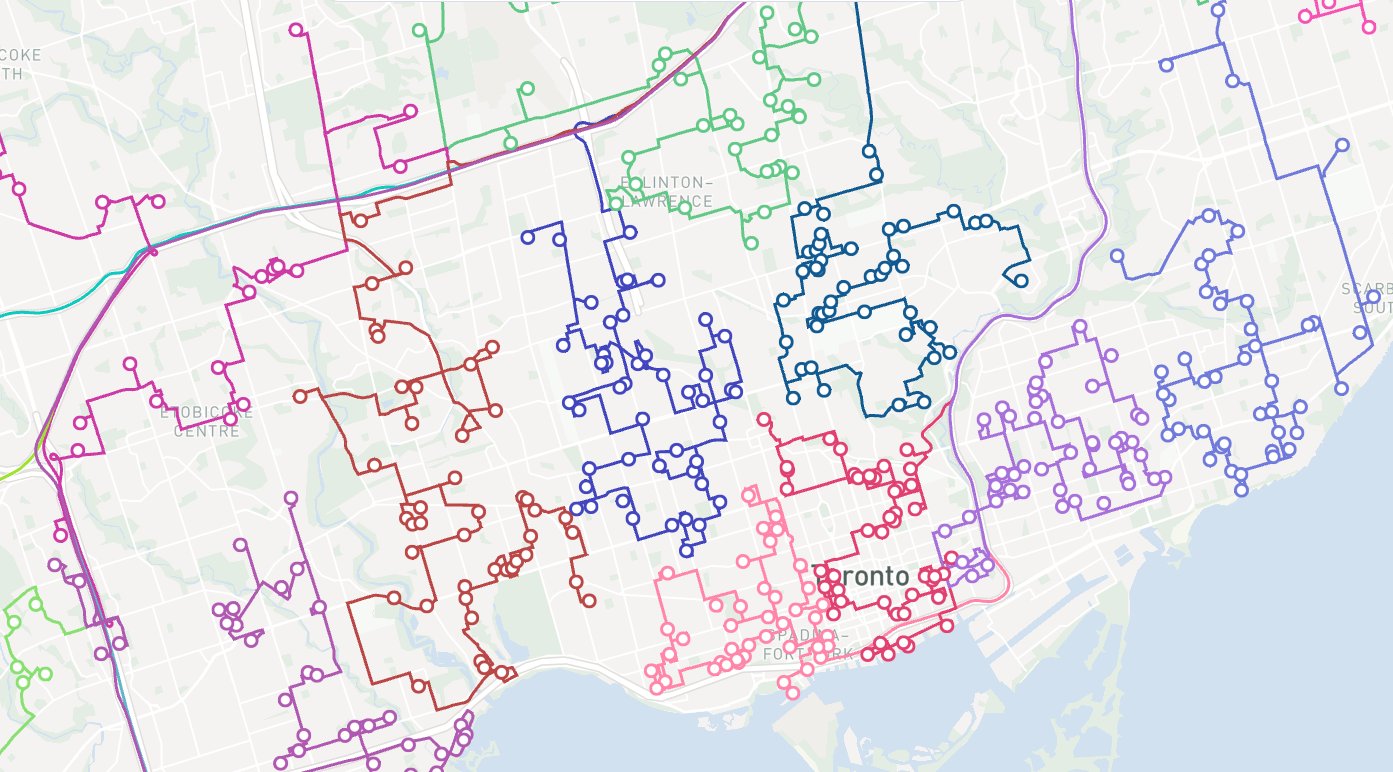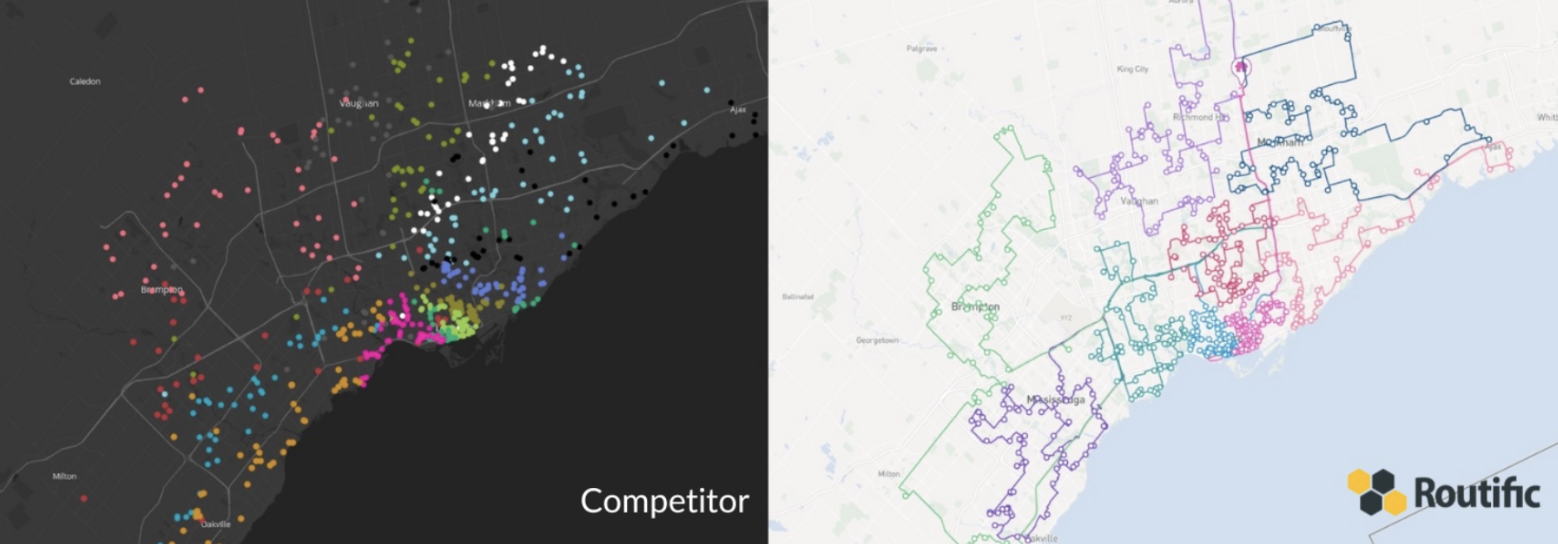The smartest and most powerful route optimization API
Looking for Routific's Platform API?Note that these APIs are designed to invoke standalone solver that returns optimized routes in JSON format. If you're looking to integrate with Routific to upload orders or fetch route information programmatically, you can check out the Routific's Platform API or the new Beta Platform API
Overview of the Routific Engine API
With Routific's API, you can integrate our proprietary routing algorithms into your own stack, so you don't need to spend your precious engineering resources developing and maintaining your own routing algos.

With a decade of route optimization R&D under our belt, we can offer the following:
- Hyper-fast optimizations up to 10,000 stops per request
- Cleanly clustered routes with minimum overlap for driver happiness
- Highly optimized routes, often 15% shorter compared to open-source engines
- Highly accurate ML-powered ETAs in 179 regions around the world
- Visualize the JSON results on the Routific platform
Routing use-cases
Our flexible API supports many different constraints and optimization parameters to match various routing use-cases. Here's just a sample of some of the most popular use-cases:
- meal delivery
- grocery delivery
- parcel delivery
- field services
- distribution logistics
- bakeries
- flower shops
- pharmacies
- laundry pickup and delivery
All these businesses have something in common – they need to plan daily routes to visit multiple stops, either with a single vehicle or with a fleet of vehicles, while meeting business constraints.
If you'd like to discuss your needs or have questions about the API, chat with an engineer.
Speed and scale of optimization
Our Routing Engine API supports requests up to 10,000 stops in a single optimization. The time it takes to finish the optimization request varies greatly depending on the constraints of the problem, but to give you a rough sense, here are some estimates:
| Problem size | Est. processing time |
|---|---|
| 250 | ~20s |
| 500 | ~1m |
| 1,000 | ~3m |
| 2,000 | ~5m |
| 4,000 | ~10m |
| 8,000 | ~25m |
Cleanly clustered routes with minimum overlap
Ever had your drivers complain about seeing their colleagues on the same street doing deliveries? Or your dispatcher saying that the routes (from another solver) are garbage, because they look like spaghetti? And they're spending hours manually fixing the routes?
Here's a picture to illustrate the Routific difference:

Spaghetti routes from a competitor on the left, cleanly clustered routes from Routific on the right.
On the left are the results of a competitive routing engine. Note how the routes are long and stringy, and how many drivers going to the same overlapping areas.
On the right are the routes from Routific: we have incorporated the human elements of driver acceptability in our algorithm.
In some cases, we might be trading off a little bit of mileage for cleaner routes. In this example case, our routes were far more efficient as well:
| Metric | Competitor | Routific | Difference |
|---|---|---|---|
| Total Distance | 2146.0 km | 1685.8 km | -460.2 km (21%) |
| Total Working Time | 93hr 08m | 73hr 28m | -19h (21%) |
| Number of routes | 14 routes | 9 routes | -5 routes (35%) |
Because the routes are tightly packed, you can squeeze more stops per route, increase route density, reduce mileage, and work time. Drivers will be happier as well, as they tend to prefer to deliver in just one area.
So, even if you already have a route optimization solution in place, routing algorithms are not all created equal – you might still be leaving 21% margins on the table!
Get your free Route Efficiency report to sanity-check the quality of your routes!
Traffic-aware route optimization: accurate ETAs with Machine Learning
We have deployed 179 ML models around the world to vastly improve the ETA accuracies by incorporating historical traffic patterns – relative to raw OpenStreetMap ETAs that don't consider traffic. We model population density, bridges, tunnels, and busy highways.
Benchmarking our ETAs against Google Maps, for a route longer than 4.5 hours, we're accurately predicting the length of the route within a 15-min margin of error in most cases. In 50% of the cases, the accuracy is within a 5-min margin.
Note that we're not simply massaging ETAs after the route optimization is finished. Other routing solutions often pull data from Google Maps and apply it in retrospect. The problem with this is that it might break time-window constraints. And you may not end up with efficient routes, because the algorithms are not traffic-aware.
The way we approach it is by feeding the ETA predictions straight into the route optimization algorithms, resulting in traffic-aware route optimization.
Coming soon: time-of-day & day-of-week routingOur current ETA prediction models assume an average throughout the day. Soon, the ETAs will also vary depending on the time-of-day and day-of-week to further increase the accuracy of the ETA predictions.
